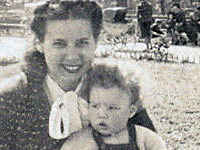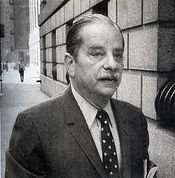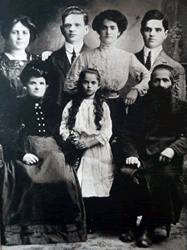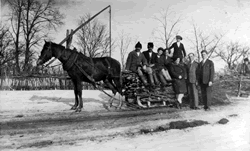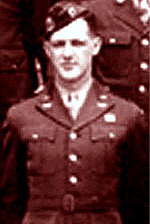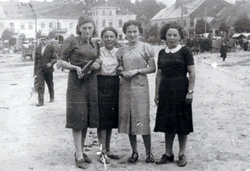#grfn-1:
Chaim Yankel Gurfein with his sister.
Basia Gurfein (now Betty Berliner) is the daughter of Lejzer and Chana
(Taubenfeld) Gurfein. She was born in 1924 in Pruchnik, Poland. Her
family moved to Lancut in 1937, where her father owned a general
store. Basia had five siblings: Cila, Sala, Shmuel Leib, Ita, and
Chaim Yankel. Shmuel immigrated to Argentina in 1932. In 1942 during
the German occupation, Basia, along with her mother and sister Cila,
were boarded on a truck for deportation. Basia managed to jump out and
escape, but the others were taken to a nearby tunnel, where they were
shot. In 1943 Basia's sister Sala and her children were discovered in
their hiding place and killed. After Sala's death, Basia and her
youngest sister, Ita, felt responsible for Sala's orphaned nephew,
Itzhak, who was no longer safe in his hiding place. They retrieved him
and took him to a poor peasant named Jozefa Dudek, who owed Sala a
favor. Jozefa hid both Itzhak and Ita in her attic for almost two
years. Basia also stayed there often, rotating her place of hiding
among several peasant families. In exchange for shelter, Basia knitted
sweaters for the families. In July 1944 Basia was liberated by the
Soviet Army. She subsequently discovered that her father had been
killed in Majdanek, and her brother Chaim Yankel, in the USSR. Soon
after the liberation, Basia met Nathan Berliner, a survivor from
Kalisz, who had been hiding in the same area. The two were married in
Wroclaw in December 1945. Shortly after their wedding Basia and
Nathan, along with Sala's nephew, Itzhak, fled to Germany with the
Bricha. They lived for several years in the Heidenheim and Landsberg
displaced persons camps until they were able to immigrate to the
United States in 1950.
#grfn-2:
Marion and Marjorie Gurfein
Marion Reh Gurfein
War: World War II, 1939-1946
Status: Civilian
Gurfein, Rivka
GURFEIN, RIVKA (1908–1983), Israeli author and literary critic. Born in Sanok, Poland, Gurfein graduated from the Cracow University. She joined Kibbutz Ein Shemer in 1932 and was appointed counselor of Youth Aliyah groups, and later cultural officer in the IDF. She was a lecturer in general literature and Hebrew poetry in the ?aderah Community College and in the Institute for Supplementary Education for Teachers in Haifa. As a member of the editorial board of Devar ha-Po'elet, she contributed articles on literature, culture, and society, and published essays and articles on general and Hebrew literature in various journals such as Orlogin, Al ha-Mishmar, and Sedemot.
Gurfein literary essays include "Mi-karov u-me-Ra?ok" (1964), "Im Shir" (1967), "Bi-Keriah Kashuvah" (1969), and "Le- Or ha-Katuv" (1972). She is also the author of novels: Ne'urim ba-Shemesh (1954), Kokhavim me-al ha-Gan (1964) – for which she was awarded the Ussishkin Prize, and Ta'am shel Be?irah (1975). She received the Histadrut Y. Aharonovitch Prize and the ?ayyim Greenberg Prize for her literary achievements and for her educational activities.
PERSONAL AD: "Mrs. Marion Gurfein requests the Captain to Please end the war in a hurry and come on home where he belongs!!" The Goofein Journal, May 26, 1943
When Marion Gurfein wrote to her husband Joe during his tours of duty in World War II and Korea, she sent him something more than letters. She created a mock newspaper, The Goofein Journal, which she hand-lettered on card stock. The Journal contained banner headlines, illustrations, photos, and "news" stories recording family events and a "social column" which kept track of their friends' whereabouts. Complementing Marion's view from the home front are Joe Gurfein's memoirs about his 26 years with the Army Corps of Engineers.
#grfn-3:
Murray Irwin Gurfein (November 17, 1907 - December 16, 1979) was a federal judge in the United States.
Born in New York City, Gurfein attended Columbia College and Harvard Law School. After graduating, he served as a law clerk to Judge Julian Mack and then as an Assistant United States Attorney in New York. He also served as an assistant in the District Attorney's office in Manhattan. During World War II, he served as a lieutenant colonel in the U.S. Army. After military service, he was an assistant to Robert H. Jackson during Jackson's service as the U.S. prosecutor in the Nuremberg Trials. He then returned to New York where he practiced as a lawyer from 1946 to 1971.
In 1971, President Richard M. Nixon appointed Gurfein as a judge of the United States District Court for the Southern District of New York. During his first week as a judge, Gurfein was assigned the Pentagon Papers case and gained national prominence when he refused the government's motion to enjoin publication of the documents. Gurfein's ruling was initially reversed by the Court of Appeals, but ultimately reinstated by the Supreme Court. Gurfein wrote: "The security of the Nation is not at the ramparts alone. Security also lies in the value of our free institutions. A cantankerous press, an obstinate press, an ubiquitous press must be suffered by those in authority in order to preserve the even greater values of freedom of expression and the right of the people to know."[1]
After three years on the District Court, Gurfein was promoted to the United States Court of Appeals for the Second Circuit, also headquartered in Manhattan. Gurfein served on the Court of Appeals from 1974 until his death in 1979
#grfn-4:
#grfn-5
The Gurfein family
#grfn-6:
Joseph Gurfein
#grfn--7
Sheila Gurfein is second from the left
#grfn-8
#grfn-9
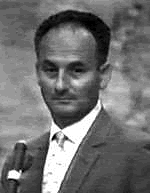
#grfn-11
The Trial of Adolf Eichmann
Session 21
Attorney General: I call Mr. Ya'akov Gurfein.
picture 1, Yaakov Gurfein
Presiding Judge: Do you speak Hebrew?
Witness Gurfein: Yes.
The witness is sworn.
Q. What is your name?
A. Ya'akov Gurfein.
Attorney General: What is your address, Mr. Gurfein?
Witness Gurfein: Tel Aviv, 33 Rehov Bloch.
Q. At the outbreak of the Second World War you were in Poland?
A. Yes.
Q. In which town?
A. In the town of Sanok.
Q. Where is that?
A. It is in Galicia.
Q. Do you recall the herding of the Jews of Sanok into a ghetto?
A. Yes, sir.
Q. When did this happen?
A. In fact they put the Jews of Sanok into a ghetto twice.
Presiding Judge: In what part of Poland is Sanok?
Witness Gurfein: In southern Poland which is called Galicia, in the
vicinity of Przemysl.
Q. Western Galicia.
A. I would say Central, seeing that it borders on the San [river].
Immediately after the war between Germany and Russia broke out, they
commanded the Jews to leave their dwellings and to concentrate in a
small residential area. The others had to evacuate their apartments
and to be confined within a number of streets, in a number of houses.
But this was not yet a closed ghetto, we were not yet surrounded by a
barbed wire fence. They took us out of there to all kinds of different
tasks, forced labour and so on.
Sometime in the month of August or July 1942, the Gestapo ordered all
the Jews of Sanok to report to the Gestapo offices for the purpose of
registering and the insertion of special stamps into our identity
cards. They called them "Kennkarten." Immediately after that they
ordered the Jewish Community to collect all the Jews and gave them
orders...
Attorney General: What was the Jewish Community? Who was in charge of
the Community?
Witness Gurfein: The Judenrat.
Q. Appointed by whom?
A. Appointed by the Gestapo. They gave orders to all the Jews to
assemble - also the Jews of the villages surrounding Sanok - in a camp
built by the Jews on orders of the Gestapo. They called this camp
Zaslav. At the beginning of September they collected all the Jews,
both of Sanok and of the surroundings, and put them into this camp. It
was well fenced off. It became apparent when a count was taken that
there were then 13,000 Jews in Sanok and the environs.
Q. Let us go back for a moment, before the ghetto period, before they
put you into the ghettos, were operations carried out against the Jews
in Sanok?
A. Yes, there were.
Q. What happened?
A. They killed Jews immediately upon the outbreak of the War - that it
to say, already in September 1939 they killed a number of Jews, burned
synagogues. One Jew who wanted to rescue a Scroll of the Law from a
synagogue was killed on the spot, and they threw him half alive into
the burning synagogue. Similarly they killed many people whom they
sought out under various pretexts. For example, they sought out Jews
who were suspected of being Communists and since they didn't find
them, they took others, people who had a similar name, or members of
their family, and killed them in Sanok.
Q. How much time did they give you to move into the ghetto?
A. They ordered us to move into the ghetto within one day, that is to
say, from one day to the next, all of us had to report. I myself
worked in Sanok in the houses of the German police. We were
constructing the buildings of the police and they allowed us, me and
the members of my family, that is to say they allowed the workers and
the members of their families to remain in this camp, closed off and
guarded by the Gestapo. At night, that same night before the first
deportations of Jews, the leaders of the Gestapo of Sanok came; I
recall the name of the Gestapo officer, his name was Albert Schulz.
Q. What was his rank?
A. He was Hauptsturmfuerer. He came together with the Gestapo official
in charge of Jewish affairs, Kratzmann, and Mueller. He stood us up in
a line at night, removed from the line people who they considered not
fit for work, that is to say old people and children, and transferred
them to the camp at Zaslav.
Q. Describe how that separation took place, when children were taken
from their mothers, what happened?
A. When the children were separated from their mothers and the parents
from their children, the women began to cry and to wail and they
begged the Gestapo men to leave them there since we were working
there. Then they replied that this was nothing - that they were simply
moving them to another residential area, and within a week we should
be able to be reunited.
At Zaslav they subsequently put 10,000 people into railway waggons.
The Gestapo men found that about 500 Jews had not reported, who had
hidden themselves in their houses or sick people who had not been fit
enough to walk to the railway waggons, or children - they put them
into the local prison. There were about 500 people, amongst them my
uncle.
And the next day, after the dispatch of the 10,000 people, they killed
the 500 persons on the spot, at Zaslav. My uncle approached the
Gestapo officer and promised him money if he would release him and the
members of his family. They moved him together with the people to the
edge of the pit and then shot about 500 people, and in the end they
kicked him and told him to run away. He then returned to our camp, I
remember this: he was covered with blood from head to foot.
Q. And he told you this story?
A. Yes. And he gave me the names of the people who were killed at that
place. We still continued working. All this happened in the month of
September, 1942.
Q. The railway line went into Zaslav?
A. In Zaslav there was once a paper factory - there was an old railway
line there which was not in use. Several months before the
deportation, the Gestapo ordered the Jews to build a new railway line
there and to construct workshops. They told us that we might be going
to work there, seeing that the German army had special need for
clothing, furs and shoes. They also ordered us to prepare the
workshops.
Q. And you believed them?
A. And we believed them, seeing that Gestapo men were coming all the
time, calling on the Jews to report and they used to declare to them
that the Fuehrer had already given orders not to deport any more Jews,
that we were needed for labour, and that there would be no more
deportations, there would be no more exterminations and there would be
no more shootings.
Q. After each deportation they used to promise this?
A. Each time, that we should not be afraid, that we should not try to
escape, that we should not create disturbances. Meanwhile we still
continued working in the place until the month of December 1942. In
the month of December they moved the remaining workers and
concentrated them in several small homes within the town of Sanok, and
from there they took us to work every day. After all the deportations,
after the exterminations, we remained only 1,300 persons out of its
population of 13,000 souls in June 1942.
Presiding Judge: 13,000 Jews in this town?
Witness Gurfein: In this town and its surroundings.
One morning, in the middle of January 1943, they woke us up. We saw
that we were surrounded by SS men who were stationed around the
ghetto. They ordered us to line up in the courtyard, allowed each one
to take a blanket, and led us on foot to the Zaslav camp. At Zaslav
they put everyone into one hall and kept us there for three days and
two nights. On Friday morning they put us into railway waggons. In the
morning we heard that a train was arriving and we saw that there were
ten railway waggons. At the railway entrance SS men stood with dogs,
and they commanded us to get into them, to crowd into these waggons.
Attorney General: How many people were there?
Witness Gurfein: We were 1,300 souls. And we were lucky. I counted the
people in our waggon - there were 103 of us.
Q. In your waggon?
A. This was a French freight waggon, and there was a notice on the
door: 8 horses or 40 people.
Q. In French?
A. Yes.
Q. Do you read French?
A. Yes. When they put us in all together into the waggons, there was
no place to stand or sit. Some of the people sat on the floor, some
stood, and then every hour we exchanged positions.
Q. Before you entered the train, how long were you closed off in that
camp at Zaslav?
A. Three days and two nights.
Q. Did they give you food?
A. They didn't give us any food or drink.
Q. Did they allow you to go outside for your personal needs?
A. They didn't allow us to go outside.
Q. Where did you relieve yourselves?
A. Everything inside this hall.
Q. In front of each other, women and children and men together?
A. Yes, together. We were inside the train for several days. They
closed the door. The windows were already shut, and also secured with
barbed wire. Towards noon the train moved. We could notice through the
aperture in the windows that the train was travelling in the direction
of Przemysl - after that in the direction of Yaroslav. We knew that
they were exterminating the Jews of the surroundings in the camp at
Belzec. We decided that if the train turned to the right in the
direction of Rawaruska, we would try to burst out of the train.
Q. To the right was in the direction of Belzec?
A. Yes.
Q. And left?
A. In the direction of Cracow. We still had only a spark of hope that
perhaps they were transferring us to Plaszow that was a labour camp
near Cracow.
Presiding Judge: All this was known to you?
Witness Gurfein: Yes. But they announced, day and night, that they
needed the trains for their victory. We couldn't understand that
nevertheless they found the time to transport the Jews for
extermination all the time and to use trains for them. On every train
there was an inscription: "Raeder muessen rollen fuer den Sieg"
(Wheels must roll for the sake of victory).
Attorney General: At that time you didn't believe that the programme
was to destroy the Jewish people?
Witness Gurfein: No.
Q. Despite the fact that you had heard reports from Belzec?
A. We received reports, but the spark of hope, nevertheless, still
flickered in our hearts and we hoped that, perhaps, despite this, some
miracle would occur. They kept promising day and night that they were
stopping the deportations, the exterminations. But in view of the fact
that the train turned in the direction of Rawaruska, we managed to
force the window open and several of the people in the train jumped
out. Each time a person jumped out, we heard shots. On each waggon
there was an SS man with a machine gun. At approximately 2 o'clock in
the morning - this was beyond Yaroslav - my mother pushed me from the
waggon and told me to jump. I jumped from the waggon.
Q. How old were you?
A. Twenty-one. I left behind, inside, my mother and my brother. I hid
in the snow. They halted the train and began to shoot in my direction.
I crossed to the other side of the track and dug myself into the snow;
I remained in the snow for two hours until I heard the train moving.
Q. Did you see your mother after this?
A. I didn't see my mother after this, nor any members of my family.
Q. How many hours were you in that horse waggon?
A. I was in that waggon from Friday morning until 2 o'clock the next morning.
Q. Did they give you any food there?
A. They gave us neither food nor drink. They didn't even allow us to
bring snow into the waggon. We wanted to quench our thirst with snow;
even this they forbade, and they shot into the waggon ahead of us
because someone had brought a little snow into it.
Q. So where could you relieve yourselves?
A. In the corner of this waggon.
Q. There were women and children there?
A. There were women and children and old people together.
Q. Before this operation, could you tell us something about the
plunder of Jewish property?
A. Yes. Immediately after the occupation of Sanok in September 1939,
the Jews were ordered to bring to the Gestapo building every object of
value in their possession under threat of the death penalty - gold,
diamonds, foreign currency. Naturally the Jews gave them up. In the
winter of 1941, the Gestapo gave orders, through the Judenrat to bring
in furs and also - for those who had them - skis. These were needed
for the German army. There were cases where people simply forgot to
bring a glove or a piece of fur. The Germans subsequently conducted
searches, took these people and brought them to Auschwitz. About one
month later they found in the possession of a certain Jew, a piece of
fur - they killed him on the spot.
Before the general deportation, they ordered the Jews to close up
their homes, to leave everything in an orderly fashion and to bring
the keys to the Gestapo building. The Jews were engaged in the
transfer of their own furniture. In every case where they found
attractive furniture, they transferred it to the local Germans. What
they did with the remainder - I don't know. I saw in the camp at
Zaslav piles upon piles of silverware, candlesticks, blankets, sheets.
They piled up everything in order. They loaded the silverware on
wheelbarrows - there was so much of it there.
Q. Tell me, at the railway station when they packed you into the train
going to Belzec, when you thought that it was likely to go to Belzec
why didn't you resist, why didn't you board the train?
A. We no longer had any strength left. Very simply, we wanted it to
end quickly. This was in 1943. After so many years we did not have the
strength to resist any more.
Q. You wanted it to end?
A. We wanted to die more quickly.
Q. Then why did you jump from the window?
A. There nevertheless was an impulse. For from the moment that we saw
that the train was going in the direction of Belzec some spark was
ignited. We saw someone jumping and some spark was kindled within
people who wanted to save themselves. I wouldn't have jumped, if my
mother hadn't pushed me forcibly.
Q. How were you saved from this hell?
A. After I jumped from the train, I went on foot in the direction of
the town of Yaroslav. From there I reached Przemysl. I didn't find a
single Jew there. I went into a house of some Christians. They allowed
me to sleep there. After this I remained for some days in Przemysl and
from there I travelled to Cracow. Cracow was a large city. I also
tried to get into the ghetto. I was inside the ghetto for a little
while. I saw that it was very bad there. I ran away from it. I hid as
a Christian. Thereafter I entered the camp at Plaszow, together with
people returning from work. Because the conditions there were so
terrible, I ran away and hid as a Christian. Subsequently I crossed
the border to Slovakia, and from Slovakia to Hungary.
Q. And from Hungary to Rumania?
A. And from Hungary to Rumania, and from Rumania to Turkey, and in
1944 I came to Palestine by train through Syria.
Q. And since then you have lived here?
A. Since then I have been here.
Q. Thank you.
Presiding Judge: Dr. Servatius - do you have any questions?
Dr. Servatius: I have no questions to this witness.
Judge Halevi: Mr. Gurfein, you mentioned the members of the SS -
Kratzmann, Mueller and Schulz.
Witness Gurfein: Schulz was the commander of the Gestapo in Sanok.
Q. And who was Kratzmann?
A. Kratzmann was the Judenreferent within the Gestapo.
Q. Where was his office?
A. In the Gestapo of Sanok.
Q. And Mueller?
A. He was also a Gestapo man in Sanok.
Q. I didn't understand what you said about them. How did they take
part in these events?
A. Kratzmann and Mueller were the most terrible Gestapo men. They also
took part in the killing of Jews. The officer Schulz reached us in
1942 from Yaroslav. Subsequently we realized that he had come
especially to organize the deportation of the Jews of Sanok. As I
mentioned, they came to us, for we were a number of Jews together with
their families within the camp of the Schutzpolizei (Civil Police). We
hoped that we would be able to remain and to work there. They arrived
that night, and saw that not all the people were capable of working.
There were also small children. Despite the fact that previously they
had allowed us to come into that camp with the members of our families
as well, they separated us from each other and left only 20 persons.
Presiding Judge: You were asked what was the role of each of these Gestapo men.
Judge Halevi: What did the three Gestapo men, whose names you mentioned, do?
Witness Gurfein: At that time they separated our families from us,
they loaded them onto trucks and transferred them to the Zaslav camp
to be deported.
Q. You stayed there?
A. We remained in the camp of the Schutzpolizei.
Q. What happened to your families?
A. They removed them to the camp at Belzec in that same train, except
for my uncle whom they gave another three months to live, and he was
shot at the time the 500 people were shot.
Q. You said something about 10,000 Jews. Were they sent away all at
the same time?
A. They were sent away together in three trains.
Q. Where to?
A. To Belzec.
Q. Was a separation made between those fit to work and others?
A. They took all the 10,000 Jews, both those who were fit to work, and
also women, children and old men.
Attorney General: The camp at Belzec was an extermination camp, not a
labour camp. There they did not separate people. There they
exterminated everyone who arrived at the place.
Judge Halevi: You spoke of a particular case of separation of the
families and that they cheated you and told you that within a short
time you would see your families again?
Witness Gurfein: This was on that night, before the deportation, when
they took the parents and the children away from us. The people who
still remained in the camp began to plead that they should leave the
families behind as they had promised. They calmed them down by saying
that this was nothing, they were taking them only to some new
habitation - we would be reunited within a week.
Q. Who said this?
A. The Gestapo commander in Sanok, Albert Schulz.
Q. That was a lie?
A. Of course, seeing that on the following day they transferred them
by train to an extermination camp.
Judge Raveh: Did you meet any other persons from your town after the War?
Witness Gurfein: Yes. I met people. There were those who hid and who
were not included in this transport. They hid with Christians and
managed in this way to be saved. But of those who were on the train, I
didn't meet anyone.
Q. Do you have an idea how many Jews of your town were saved?
A. I think that it would be possible to count them on the fingers of
one hand - five or six people.
Q. Out of a population of 13,000?
A. Yes.
Q. Did your uncle survive?
A. No. They took him on the second transport and he perished
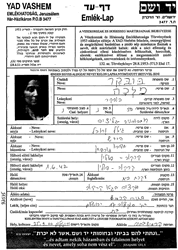
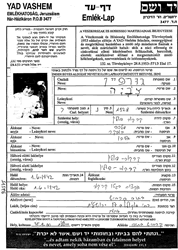
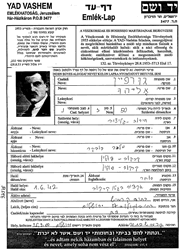
#grfn-12:
Reports by Regina BINENSTOK
Frida Shtrasberg nee Gurfein was born in Chyrow in 1898 to Shprintza
and Mendel. She was married to Wili and had 3 children. Prior to WWII
she lived in Chyrow, Poland. During the war she was in Chyrow, Poland.
Frida was murdered in 1942 in the Shoah at the age of 44. This
information is based on a Page of Testimony (displayed on left)
submitted by her sister
Meir Gurfein was born in Chyrow in 1900 to Shprintza and Mendel. He
was married and had 4 children. Prior to WWII he lived in Krakow,
Poland. During the war he was in Krakow, Poland. Meir was murdered in
Krakow, Ghetto. This information is based on a Page of Testimony
(displayed on left) submitted by his sister
Elias Gurfein was born in Chyrow to Shprintza and Mendel. He was
married and had 3 children (Mendel,Tzipka . Prior to WWII he lived in
Krakow, Poland. During the war he was in Krakow, Poland. Elias was
murdered in the Shoah. This information is based on a Page of
Testimony (displayed on left) submitted by his sister.
Sprinca Gurfein nee Braunshtein. She was married to Mendil. Prior to
WWII she lived in Chyrow, Poland. During the war she was in Chyrow,
Poland. Sprinca was murdered in the Shoah at the age of 65. This
information is based on a Page of Testimony (displayed on left)
submitted by her daughter.
Naftali Gurfein was born in Chyrow to Shprintza and Mendl. He was
married and had a daughter Ita. Prior to WWII he lived in Dobromil,
Poland. During the war he was in Dobromil, Poland. Naftali was
murdered in the Shoah. This information is based on a Page of
Testimony (displayed on left) submitted by his sister.
Klara Unger nee Gorfein was born in Chyrow to Mendel. She was married
and had 3 children. Prior to WWII she lived in Chyrow, Poland. During
the war she was in Chyrow, Poland. Klara was murdered in the Shoah.
This information is based on a Page of Testimony (displayed on left)
submitted by her sister.
Jenta Isman nee Gorfein was born in Chyrow in 1915 to Mendel and
Shprintza. She was married and had a son Mendel. Prior to WWII she
lived in Chyrow, Poland. During the war she was in Chyrow, Poland.
Jenta was murdered in 1941 in the Shoah at the age of 26. This
information is based on a Page of Testimony (displayed on left)
submitted by her sister.
Blumka Tukhman nee Gorfein was born in Chyrow in 1907 to Shprintza.
She was married to David. Prior to WWII she lived in Krakow, Poland.
Blumka was murdered in Krakow, Poland. This information is based on a
Page of Testimony (displayed on left) submitted by her sister.
Batia KERMISH gave reports;
Eliahu Gorfein was born in Chirow. He was married to Malka nee Bobker.
Prior to WWII he lived in Krakow, Poland. During the war he was in
Krakow, Ghetto. Eliahu was murdered in 1942 in Krakow, Ghetto at the
age of 50. This information is based on a Page of Testimony (displayed
on left) submitted by his daughter)r. More Details...
Malka Bobker was born in Kombornia to Hirsh and Gitel. She was a
housewife and married to Eliahu Gurfein. Prior to WWII she lived in
Krakow, Poland. During the war she was in Krakow, Poland. Malka was
murdered in Krakow, Ghetto at the age of 50. This information is based
on a Page of Testimony (displayed on left) submitted by her daughter
Tzvia Gorfein was born in Krakow in 1928 to Eliahu and Malka. She was
a teenager. Prior to WWII she lived in Krakow, Poland. During the war
she was in Krakow, Poland. Tzvia was murdered in 1942 in Krakow,
Ghetto. This information is based on a Page of Testimony (displayed on
left) submitted by her sister.
Debora Steuer nee Gurfin was born in Cheruv in 1876 to Mendel and
Yenta. She was married to Yosef. Prior to WWII she lived in Cheruv,
Poland. During the war she was in Cheruv, Poland. Debora was murdered
in at the age of 64. This information is based on a Page of Testimony
(displayed on left) submitted by her daughter. More Details...
Akiba Gurfein was born in Chirow in 1878 to Shaia Mendel and Yente. He
was a merchant and married to Rivka. Prior to WWII he lived in
Lizensk, Poland. During the war he was in Lizensk, Poland. Akiba was
murdered in the Shoah. This information is based on a Page of
Testimony (displayed on left) submitted by his niece.
reports by Yehoshua Feldman:
Meimale Gorfein was born in Chirow to Meir Yechiel and Sali. She was a
housewife and single. Prior to WWII she lived in Chirow, Poland.
During the war she was in Chirow, Poland. Meimale was murdered in
Chirow, Poland at the age of 27. This information is based on a Page
of Testimony (displayed on left) submitted by her nephew (son of her
sister)
Yosel Gorfein was born in Chirow to Khil and Sali. He was a roofer.
Prior to WWII he lived in Chirow, Poland. During the war he was in
Chirow, Poland. He was murdered in Chirow, Poland at the age of 35.
This information is based on a Page of Testimony (displayed on left)
submitted by his sis' son
Khaim Gorfein was born in Chirow in 1893 to Meir. He was a merchant.
Prior to WWII he lived in Pshemishl, Poland. During the war he was in
Pshemishl, Poland. Khaim was murdered in 1943 in Belzec, Poland at the
age of 50. This information is based on a Page of Testimony (displayed
on left) submitted by his sister' son
Leibush Gorfein was born in Chirow to Meir and Sali. He was a ????
???? and single. Prior to WWII he lived in Chirow, Poland. During the
war he was in Chirow, Poland. Leibush was murdered in the Shoah at the
age of 44. This information is based on a Page of Testimony (displayed
on left) submitted by his sisters' son.
Shmuel Gorfein was born in Chirow to Yekhiel and Sali. He was a
flourmill owner and married. Prior to WWII he lived in Chirow, Poland.
During the war he was in Chirow, Poland. Shmuel was murdered in the
Shoah at the age of 48. This information is based on a Page of
Testimony (displayed on left) submitted by his sisters' son
Cippre Roth nee Gorfein was born in Chyrow. She was married. Prior to
WWII she lived in Chyrow, Poland. During the war she was in Chyrow,
Poland. Cippre was murdered in Chyrow, Poland. This information is
based on a Page of Testimony (displayed on left) submitted by her
relative from Brazil.NADEL
Submitter's Last Name CWERNER
Submitter's First Name HELLA

